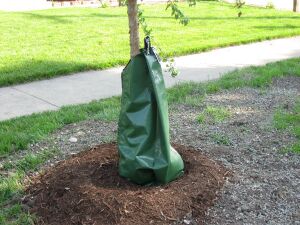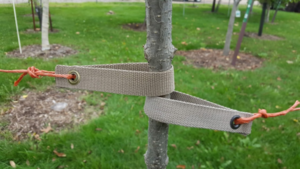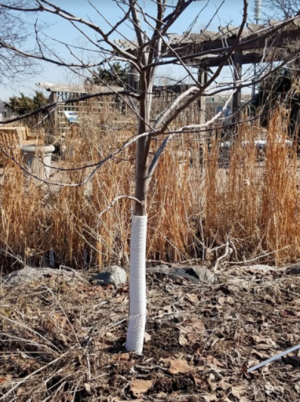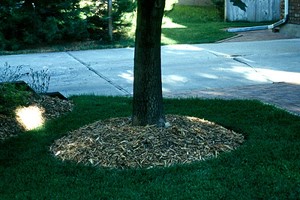
Operation and maintenance of tree trenches and tree boxes - supplemental information
This page provides supplemental information on operation and maintenance (O&M) of tree trenches and tree boxes. To see information on design phase, construction phase, and post-construction phase O&M, including inspection checklists, see the page called Operation and maintenance (O&M) of tree trenches and tree boxes.
Contents
Supplemental watering

Newly planted trees need to be watered regularly. In the first three years after planting, trees typically need about 1.5 gallons of water per inch of trunk diameter whenever the soil feels dry or slightly damp in the top 6 inches (Johnson et al., 2008) and a minimum of once a week during the first growing season. However, the amount of water the tree needs will depend on many factors, including soil type, drainage and weather. Soil moisture sensors can be used to automate watering whenever the soil is dry enough to need watering.
Many people have found that one of the most reliable ways to ensure trees receive adequate water during the establishment phase is to minimize labor involved, by using watering bags or an automated watering system. Watering bags are cone shaped bags that hold about 20 gallons of water and zip around the tree trunk. They can be used for trees with a caliper between 1 and 8 inches. Once they are manually filled with water, they release water slowly directly above the root package, providing slow, deep, watering without losing any water to runoff evaporation. They are reusable, inexpensive and easy to use.
Once the tree has rooted out of the root package, watering should be tapered off to encourage the tree to grow deep, wide-spreading roots. Depending on factors such as, tree species, soil type, perviousness of the surface above the tree rooting zone, weather, and how much stormwater is directed to the tree, mature trees may also require supplemental watering during extended droughts. Urban trees are especially prone to drought as urban areas are typically warmer and there is often less pervious surface above the rooting zone of an urban tree. Soil moisture should be checked and trees watered as needed from spring until the soil freezes in the fall. Water whenever soil is dry 3 inches below the soil surface. Too much water can kill trees just as easily as not enough water, especially in compacted and degraded urban soils, so ensure trees receive enough water but are not overwatered.
To mimic the pre-settlement hydrological cycle as closely as possible by increasing both evapotranspiration and infiltration, harvest runoff, for example, from adjacent impervious surfaces, and use harvested runoff to irrigate trees. In urban areas dominated by impervious surfaces, evapotranspiration and infiltration are typically lower than in the pre-settlement hydrological cycle. Using harvested water to irrigate trees will increase both evapotranspiration and infiltration, and more closely mimic the pre-settlement hydrologic cycle.
Pruning
Trees are pruned for safety, health and aesthetics. Johnson et al. (2008) recommend the following pruning frequency:
- once in year 2 or 3 after planting;
- every three years during years 4 to 10 after planting; and
- after 10 years from planting, every 5 years for deciduous trees and as needed for conifers.
Check with your city or town to see if they have laws regarding pruning. Never prune trees or branches that are within 10 feet of utility lines; contact the utility company. Pruning guidelines can be found in
- pages 18-23 of Johnson et al. (2008),
- the University of Florida’s pruning guidelines (2011), and
- Gilman (2011).
Staking and straightening

Staking, if used, should be removed 1 to 2 years after planting. Check staking and tree guying material at the end of the first growing season after planting. If the tree is stable without the stake and guying material, remove stake and guys. If tree is unstable, retie guying to stake and remove stake and guying at the second growing season after planting.
Maintain all plants in a plumb position throughout the warranty period. Straighten all trees that move out of plumb including those not staked. Plants to be straightened should be excavated and the root ball moved to a plumb position, and then re-backfilled.
For more information on tree guying and staking, link here.
Protecting the trunk

The bark of young deciduous trees should be protected with a trunk guard to prevent rabbits, mice, and deer from damaging the trunk. Trunk wounding can create long term damage. Install light colored plastic tubing, or ¼ inch mesh hardware cloth around the trunk with 1 to 4 inches of space between the guard and the trunk. The guard should extend 1 to 2 feet above the snowline for protection from small rodents, and as tall as possible for deer protection. It should be pushed into the ground or mulch about an inch to secure it but not enough to damage the roots. The guard should be in place at a minimum during winter months, but can be left in place year round if it does not touch the trunk. Enlarge or remove trunk guard once there is no longer at least 1 inch between the tree trunk and tree guard.
For more information on tree protection, link here.
Mulching

Wood mulch provides many benefits to the tree, including, for example, weed and turf suppression, and increased moisture retention. It also improves pollutant removal and increases the organic matter content of the soil.
Maintain a ring of mulch as wide as possible, 2 to 3 inches deep, around each tree. Ideally each tree should have at least an area two feet in diameter for each inch of tree trunk diameter, with a minimum mulch ring diameter of eight feet for trees with a stem diameter three inches or less (Gilman, 2013). This may not be feasible in urban areas. Where the tree opening does not permit an eight foot wide mulch ring, make the mulch ring as large as the tree opening permits.
Do not pile mulch against the trunk of the tree, and place only a thin layer or no mulch over the root ball. According to Gilman (2013), “This keeps the trunk dry and allows rainwater, irrigation, and air to easily enter the root ball. Mulch resting on the trunk or layered too thick can kill the plant by starving it of oxygen, killing the bark, causing stem and root decay, preventing hardening off, encouraging rodent damage to the trunk, keeping soil too wet, and repelling water. Mulch on the root ball has little impact on water lost from the tree since most of the moisture that leaves the root ball does so by transpiration, not evaporation. Only a small amount (less than 10 percent) leaves the root ball by evaporation from the surface of the root ball.”
Note that many practitioners are minimizing the use of mulch or using alternatives to mulch to control weeds. Using mulch can cause clogging of inlet, outlet, and bypass pipes, and can introduce invasive species such as jump worms. Alternatives to mulch include ground vegetation such as clover or sedges, or arranging plantings in more dense configurations so as to minimize use of mulch.
For more information, see the following.
- Mulching Landscape Trees
- How to Mulch Trees the Right Way
- Top 3 Mistakes Made When Mulching Trees - Youtube
- Effective mulching - Youtube
Fertilizers
Most trees generally do not need to be fertilized regularly, especially if they are receiving nutrient rich stormwater. Trees should not be fertilized with nitrogen unless diagnosis by an arborist deems it necessary. Other nutrients should be applied only if soil tests indicate the soil has insufficient nutrients.
If soil tests or diagnosis by an arborist indicate a need to fertilize, follow these guidelines.
- Do not apply more fertilizer than the soil lab or arborist recommends. Overdosing could harm the tree and leach nutrients into downstream water bodies.
- Water well before and after fertilizing.
- Fertilize in the fall after the tree has lost its leaves, or in the spring before buds develop.
If fertilizer is needed, use a slow release fertilizer.
Check tree safety
Johnson et al. (2008) recommends checking trees after storms for the following signs of potential danger.
- Broken, dead, or hanging branches
- Cracks, fungi, and cavities
- Weak trunk or branch unions
- Encircling root compressing the trunk (a flat sided trunk at the ground level is a good indicator)
- Recent lean (especially if the soil or grass has lifted on one side)
If any of the above are found, contact an arborist. Guidance on how to hire an arborist can be found on page 28 of Johnson et al 2008, and on the International Society of Arboriculture’s website.
More details on assessing the health and performance of trees can be found here.
Tree health troubleshooting guidelines (adapted from Johnson et al., 2008).
Link to this table
| If you see: | Potential cause: | You should: |
|---|---|---|
| A flat-sided trunk at the base of the tree | Encircling root restriciting the flow of water and nutrients between the roots and rest of the tree | Excavate to check for encircling root |
| Bark damage near the bottom of the tree | Rodent or string trimmer | Apply mulch/trunk guard to protect from further damage |
| An elm tree with liquid oozing from the trunk | Slime flux or wetwood | Not worry about health |
| An elm tree with bright yellow leaves on one or two branches | Dutch elm disease | Immediately call the university* or an arborist |
| Webs in the branches or webs covering the tips of branches | Fall webworm or Eastern tent caterpillar | Not worry about health |
| Many branch tips snipped off and laying on the ground | Squirrel damage | Not worry about health |
| Black clumps on branches of a cherry tree | Black knot | Call for advice* |
| Very little growth | Many | Call for advice* |
| Hole in trunk or branches | Many | Call for advice* |
| Leaves sticky and covered with a black velvety coating (like soot) | Piercing, sucking insect and sooty mold | Hose down leaves to get rid of sap |
| Leaves wilted | Many | Call for advice* |
| Spots on leaves | Many | Call for advice* |
| Small leaves | Many | Call for advice* |
| Sparse leaves | Many | Call for advice* |
| Yellow or brown leaves | Many | Call for advice* |
| Holes in leaves | Insect feeding | Not worry about health |
| Bumps on leaves | Many | Not worry about health |
| *Call an arborist or other qualified professional | ||
References
- Gilman, Ed. 2011. Illustrated Guide to Pruning. 3rd edition. Cengage Learning: Independence, KY.
- Gilman, Edward F. 2011. Specifications for Planting Trees and Shrubs in the Southeastern U.S.. Document ENH856. Environmental Horticulture, Florida Cooperative Extension Service,Institute of Food and Agricultural Sciences, University of Florida.
- Gilman, Edward F. 2013. Sample planting specifications for trees. Environmental Horticulture Department, University of Florida Gainesville.
- Johnson, Jill, Gary Johnson, Maureen McDonough, Lisa Burban, and Janette Monear. 2008. Tree Owner's Manual for the Northeastern Midwestern United States. United States of Agriculture, Forest Service,Northeastern Area, State and Private Forestry, NA-FR-04-07.
- Urban, J. 2012. Draft Tree Planting Specification. Prepared for 2012 International Society of Arboriculture Conference.
Related pages
Green Infrastructure
- Green Stormwater Infrastructure (GSI) and sustainable stormwater management
- Operation and maintenance of green infrastructure practices
- Operation and maintenance of bioretention and other stormwater infiltration practices
- Operation and maintenance of bioretention and other stormwater infiltration practices - supplemental information
- Operation and maintenance (O&M) of tree trenches and tree boxes
- Operation and maintenance of tree trenches and tree boxes - supplemental information
- Operation and maintenance (O&M) of green roofs
- Operation and maintenance of green roofs - supplemental information
- Operation and maintenance (O&M) of swales
- Operation and maintenance of swales - supplemental information
- Operation and maintenance (O&M) of filter strips
- Operation and maintenance of filter strips - supplemental information
- Operation and maintenance (O&M) of stormwater and rainwater harvest and use/reuse practices
- Operation and maintenance (O&M) of stormwater and rainwater harvest and use/reuse practices - supplemental information
- Operation and maintenance (O&M) of stormwater treatment wetland practices
- Operation and maintenance (O&M) of permeable pavement
- Operation and maintenance (O&M) of permeable pavement - supplemental information
General information on trees
- Overview for trees
- Types of tree BMPs
- Plant lists for trees
- Street sweeping - this page provides a summary of an on-going project to develop a street sweeping credit
- Street sweeping for trees
- References for trees
- Supporting material for trees
- Neat websites and articles for trees
- Links to tree ordinances and forest management master plans
- Green Infrastructure benefits of tree trenches and tree boxes
Tree trenches and tree boxes
- Design guidelines for tree quality and planting - tree trenches and tree boxes
- Design guidelines for soil characteristics - tree trenches and tree boxes
- Construction guidelines for tree trenches and tree boxes
- Protection of existing trees on construction sites
- Operation and maintenance of tree trenches and tree boxes
- Assessing the performance of tree trenches and tree boxes
- Calculating credits for tree trenches and tree boxes
- Case studies for tree trenches and tree boxes
- Soil amendments to enhance phosphorus sorption
- Green Infrastructure benefits of tree trenches and tree boxes
- Summary of permit requirements for infiltration
- Tree trench/box photo gallery
- Fact sheet for tree trenches and tree boxes
- Requirements, recommendations and information for using trees as a BMP in the MIDS calculator
- Requirements, recommendations and information for using trees with an underdrain as a BMP in the MIDS calculator
Urban Forestry
For more information on urban forestry, we suggest visiting the following websites.
- Urban and Community Forestry - USDA Forest Service
- Urban Forestry & Ecosystem Management - City of Philadelphia
- Watershed Forestry Resource Guide - Center for Watershed Protection and US Forest Service - Northeastern Area State & Private Forestry
- American Forests
- Urban Forestry - Virginia Tech University
- Stormwater to Street Trees: Engineering Urban Forests for Stormwater Management - U.S. EPA
- Green Step Cities. This page provides a summary of urban forestry practices that cities can implement to help become a Green Step City and a list of cities that are implementing the practices, including links.
This page was last edited on 9 February 2023, at 16:12.

